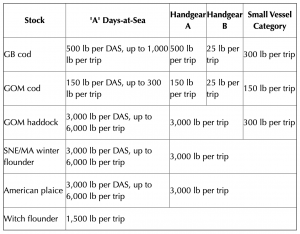April 21, 2021 — The following was released by NOAA Fisheries:
Effective May 1
We are setting common pool possession and trip limits to ensure that the common pool groundfish fishery is able to fully utilize its available quotas. Effective on May 1, these possession and trip limits were developed based on the common pool sub-Annual Catch Limits set by Framework Adjustment 59 to the Northeast Multispecies Fishery Management Plan. We also considered preliminary 2021 sector rosters, expected common pool participation, common pool fishing activity in previous fishing years, and that Framework 61 is still being considered for approval. During the fishing year, we will monitor common pool catches, and will adjust common pool management measures, as necessary.
Additionally, Northeast multispecies vessels may not target yellowtail flounder within the Closed Area II Yellowtail Flounder/Haddock Special Access Program (SAP) in fishing year 2021. Northeast multispecies vessels are not allowed to fish in this SAP using flounder trawl nets, but may fish in this SAP to target haddock with a haddock separator trawl, a Ruhle trawl, or hook gear. This SAP is open from August 1, 2021, through January 31, 2022.
Lastly, the Regular B Days-at-Sea (DAS) program is closed for fishing year 2021. During this closure, Northeast multispecies vessels may not declare or use regular B DAS.
For more details, read the notice as filed in the Federal Register and the permit holder bulletin.

